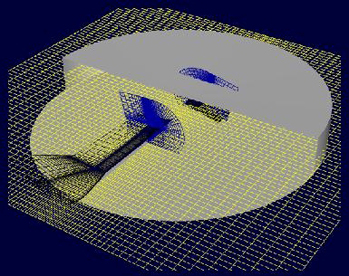OVERSET GRID METHODS FOR PREDICTING
ROTORCRAFT AERODYNAMICS AND ACOUSTICS
Earl Duque
Roger Strawn
US Army Aeroflightdynamics Directorate
Jasim Ahmad
MCAT Inst.
NASA Ames Research Center
Moffett Field, CA 94035-1000

Overset grids and Kirchhoff surface for a two-bladed rotor system
Research Objective:
Future rotorcraft must have low noise if they are to operate near heavily populated areas. This is particularly true for tiltrotors as they descend for landings. This project aims to predict the aerodynamics and acoustics of rotorcraft by solving the Navier-Stokes equations on a series of overset computational grids that surround the rotor blades.
Approach:
The overall scheme uses a finite-difference Navier-Stokes flow solver to compute the aerodynamic flowfield near the rotor blades. The equations are solved on a system of overset grids that allow for prescribed cyclic and flapping blade motions and capture the interactions between the rotor blades and wake. The far-field noise is computed with a Kirchhoff integration over a surface that completely encloses the rotor blades. Interpolation of flowfield data onto this Kirchhoff surface uses the same overset-grid techniques that are used in the flow solver.
Accomplishment Description:
As a demonstration of the overall scheme, aerodynamic and acoustic solutions were generated for a two-bladed rotor in forward flight. Far-field acoustic results were compared to experimental microphone data for two different flight conditions. Computed high-speed impulsive noise showed good agreement with experimental data, but it is clear that the Navier-Stokes flow solver requires improved grid resolution in order to accurately model the details of blade-vortex interaction noise. Four overset grids were used in the flow solver with a total of 1.25 million grid points. Each periodic flowfield solution required approximately three blade revolutions and 24 CRAY C-90 CPU hours.
Significance:
The overset-grid CFD scheme provides a powerful new framework for the prediction of rotorcraft noise. Two important features of the new formulation distinguish it from other approaches. First, the rotor wake is captured as part of the overall solution. Second, the formulation includes realistic rotor blade motions. These features provide a highly flexible computational tool for the prediction of rotor airloads and noise.
Future Plans:
Future efforts will aim to reduce numerical dissipation in the rotor wake. High-order spatial and temporal differencing schemes will be used with solution-adaptive grids to improve the rotor wake resolution. High-fidelity rotor wake simulations will dramatically improve our blade-vortex interaction noise predictions for helicopters and tiltrotors.
Related Publications:
Ahmad, J., Duque, E. P. N. and Strawn, R. C., "Computations of Rotorcraft Aeroacoustics Using a Combined Navier-Stokes/Kirchhoff Method," presented at the 22nd European Rotorcraft Forum, Brighton, UK, Sept. 16-19, 1996.
Duque, E. P. N., Strawn, R. C., Ahmad, J. and Biswas, R., "An Overset Grid Navier-Stokes/Kirchhoff-Surface Method for Rotorcraft Aeroacoustic Predictions," AIAA-96-0152, presented at the 34th Aerospace Sciences Meeting, Reno, NV, Jan. 15-18, 1996.
Point of Contact:
Roger Strawn
NASA Ames Research Center
Moffett Field CA 94035-1000